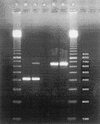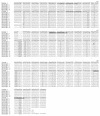Detection of Ureaplasma urealyticum by PCR and biovar determination by liquid hybridization
- PMID: 9774567
- PMCID: PMC105303
- DOI: 10.1128/JCM.36.11.3211-3216.1998
Detection of Ureaplasma urealyticum by PCR and biovar determination by liquid hybridization
Abstract
An assay which combines the direct detection of Ureaplasma urealyticum with biovar determination was developed and applied to 618 urogenital specimens. U. urealyticum was detected by inhibitor-controlled PCR. A 429-bp fragment of the urease gene was amplified. The amplicons were labelled with digoxigenin during PCR. Biovar determination was performed by liquid hybridization with biotin-labelled biovar-specific probes, and the hybrids were detected with peroxidase-conjugated sheep anti-digoxigenin immunoglobulin G Fab fragments. Results of PCR and culture for 453 urogenital specimens from women and 105 urethral specimens from men could be compared. Among the specimens from women, 63% were PCR positive as well as culture positive, 0.9% were positive only by PCR, and 4% were positive only by culture. Among the specimens from men, 15% were PCR positive as well as culture positive, 1% were positive only by PCR, and 9% were positive only by culture. By using culture as the reference method, the PCR had a sensitivity of 94% and a specificity of 98% when applied to specimens from women and a sensitivity of 64% and a specificity of 99% when applied to specimens from men. Overall, 80% of the PCR-positive specimens contained biovar 1,13.5% contained biovar 2, and 6.5% contained both biovars.
Figures





Similar articles
-
Comparative analysis and serovar-specific identification of multiple-banded antigen genes of Ureaplasma urealyticum biovar 1.J Clin Microbiol. 1999 Mar;37(3):538-43. doi: 10.1128/JCM.37.3.538-543.1999. J Clin Microbiol. 1999. PMID: 9986808 Free PMC article.
-
Detection and biovar discrimination of Ureaplasma urealyticum in Indian patients with genital tract infections.Diagn Microbiol Infect Dis. 2008 Jan;60(1):95-7. doi: 10.1016/j.diagmicrobio.2007.07.004. Epub 2007 Sep 21. Diagn Microbiol Infect Dis. 2008. PMID: 17889479
-
Molecular detection of Ureaplasma urealyticum infection from clinical urogenital swabs.Folia Microbiol (Praha). 2007;52(4):443-6. doi: 10.1007/BF02932101. Folia Microbiol (Praha). 2007. PMID: 18062195
-
Real-time TaqMan polymerase chain reaction assays for quantitative detection and differentiation of Ureaplasma urealyticum and Ureaplasma parvum.Diagn Microbiol Infect Dis. 2007 Apr;57(4):373-8. doi: 10.1016/j.diagmicrobio.2006.09.006. Epub 2006 Dec 1. Diagn Microbiol Infect Dis. 2007. PMID: 17141453
-
Ureaplasma: current perspectives.Indian J Med Microbiol. 2015 Apr-Jun;33(2):205-14. doi: 10.4103/0255-0857.154850. Indian J Med Microbiol. 2015. PMID: 25865969 Review.
Cited by
-
Detection of Ureaplasma biovars and polymerase chain reaction-based subtyping of Ureaplasma parvum in women with or without symptoms of genital infections.Eur J Clin Microbiol Infect Dis. 2009 Jun;28(6):641-6. doi: 10.1007/s10096-008-0687-z. Epub 2009 Jan 8. Eur J Clin Microbiol Infect Dis. 2009. PMID: 19130104
-
Ureaplasma urealyticum biovar determination in women attending a family planning clinic in Guiné-Bissau, using polymerase chain reaction of the multiple-banded antigen gene.J Clin Lab Anal. 2002;16(2):71-5. doi: 10.1002/jcla.10023. J Clin Lab Anal. 2002. PMID: 11948794 Free PMC article.
-
Spontaneous bacterial pericarditis with tamponade due to Ureaplasma spp.J Clin Microbiol. 2009 Jun;47(6):1965-8. doi: 10.1128/JCM.00352-09. Epub 2009 Apr 22. J Clin Microbiol. 2009. PMID: 19386833 Free PMC article. Review.
-
Molecular methods for the detection of Mycoplasma and ureaplasma infections in humans: a paper from the 2011 William Beaumont Hospital Symposium on molecular pathology.J Mol Diagn. 2012 Sep;14(5):437-50. doi: 10.1016/j.jmoldx.2012.06.001. Epub 2012 Jul 20. J Mol Diagn. 2012. PMID: 22819362 Free PMC article. Review.
-
Detection and characterization of human Ureaplasma species and serovars by real-time PCR.J Clin Microbiol. 2010 Aug;48(8):2715-23. doi: 10.1128/JCM.01877-09. Epub 2010 Jun 16. J Clin Microbiol. 2010. PMID: 20554828 Free PMC article.
References
-
- Abele-Horn M, Wolf C, Dressel P, Pfaff F, Ruckdeschel G. Polymerase chain reaction versus culture for detection of Ureaplasma urealyticum and Mycoplasma hominis in the urogenital tract of adults and the respiratory tract of newborns. Eur J Clin Microbiol Infect Dis. 1996;7:595–598. - PubMed
-
- Blanchard A. Urea plasma urealyticum urease genes; use of a UGA tryptophan codon. Mol Microbiol. 1990;4:669–676. - PubMed
-
- Blanchard A, Hentschel J, Duffy L, Baldus K, Cassell G H. Detection of Ureaplasma urealyticum by polymerase chain reaction in the urogenital tract of adults, in amniotic fluid, and the respiratory tract of newborns. Clin Infect Dis. 1993;17:S148–S153. - PubMed
Publication types
MeSH terms
Substances
LinkOut - more resources
Full Text Sources
Molecular Biology Databases

